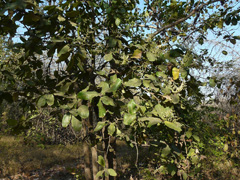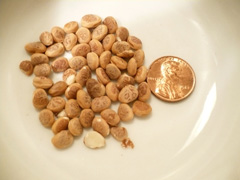 |
|
wikimedia.org |
 |
| wikimedia.org User:Badagnani |
Translate this page:
Summary
Buchanania lanzan or Almondette is an evergreen tree that grows around 18 m tall and is found in East Asia. The fruit is eaten fresh or dried for later consumption. Almondette has an almond-flavoured seeds known as 'charoli' that is used mainly in India as a cooking spice and dessert. The seed produces oil with a sweet flavour and pleasant scent thus it can be used as substitute for almond or olive oil. Moreover, it is used in Ayurveda and Unani medicine. Gum obtained from the tree is used as treatment for leprosy. The roots, on the other hand, are used against diarrhoea, the leaves against skin ailments, and the fruits against coughs and asthma. The wood of Almondette is of poor quality hence usage is limited as firewood and for charcoal-making.
Seeds are known as charoli or chironji. Buchanania lanzan Spreng. is a synonym of Buchanania cochinchinensis (Lour.) M.R.Almeida
Physical Characteristics

 Buchanania lanzan is an evergreen Tree growing to 12 m (39ft) by 10 m (32ft) at a medium rate.
Buchanania lanzan is an evergreen Tree growing to 12 m (39ft) by 10 m (32ft) at a medium rate.
See above for USDA hardiness. It is hardy to UK zone 10.
Suitable for: light (sandy), medium (loamy) and heavy (clay) soils and can grow in nutritionally poor soil. Suitable pH: mildly acid, neutral and basic (mildly alkaline) soils. It cannot grow in the shade. It prefers dry or moist soil.
UK Hardiness Map
US Hardiness Map
Synonyms
Note:Buchanania lanzan Spreng. is a synonym of Buchanania cochinchinensis (Lour.) M.R.Almeida. Buchanania cochinchinensis (Lour.) M.R.Almeida Buchanania latifolia Roxb.
Plant Habitats
Edible Uses
Edible Parts: Fruit Oil Seed
Edible Uses: Gum Oil
Seed - raw or cooked[ 46 , 301 , 310 ]. An excellent flavour, somewhat reminiscent of almonds or pistachios[ 63 , 301 ]. Eaten as a dessert seed and also used in sweetmeats[ 46 , 63 ]. In some parts of India the dried fruit and seed are baked together to make a sort of bread[ 63 ]. They are ground into powders for thickening savory sauces and flavoring batters, and stewed into rich, meaty kormas. The seed contains about 50% oil[ 63 ]. The seed is fairly small, about 7mm long[ 63 ]. After the hard shell is cracked, the stubby seed within is as soft as a pine nut. The fruit hangs on the tree for quite a long while after it has ripened[ 372 ]. Fruit - a pleasant, sweetish, subacid flavour[ 301 , 335 ]. Eaten fresh, or dried for later use[ 335 ]. The fruit is 15mm long[ 335 ]. An oil is obtained from the seed[ 301 , 335 ]. Light yellow with a sweet flavour and pleasant aroma, it can be used as a substitute for almond or olive oil[ 63 , 301 ]. Carbon Farming - Staple Crop: protein-oil.
References More on Edible Uses
Medicinal Uses
Plants For A Future can not take any responsibility for any adverse effects from the use of plants. Always seek advice from a professional before using a plant medicinally.
Acrid Antiasthmatic Antidiarrhoeal Antitussive Astringent Depurative Leprosy Skin
The gum from the tree is used against leprosy in traditional medicine[ 310 ]. Charoli seeds are used in the Ayurveda and Unani systems of medicine. The roots are acrid, astringent, cooling, depurative and constipating. They are useful in the treatment of diarrhoea[ 372 ]. The leaves are used in the treatment of skin diseases[ 372 ]. The fruits are used in treating coughs and asthma[ 372 ].
References More on Medicinal Uses
The Bookshop: Edible Plant Books
Our Latest books on Perennial Plants For Food Forests and Permaculture Gardens in paperback or digital formats.

Edible Tropical Plants
Food Forest Plants for Hotter Conditions: 250+ Plants For Tropical Food Forests & Permaculture Gardens.
More

Edible Temperate Plants
Plants for Your Food Forest: 500 Plants for Temperate Food Forests & Permaculture Gardens.
More

More Books
PFAF have eight books available in paperback and digital formats. Browse the shop for more information.
Shop Now
Other Uses
Charcoal Fuel Gum Oil Soil stabilization Tannin Wood
Other uses rating: Medium (3/5). Agroforestry Uses: A good species for afforesting bare hill slopes[ 372 ]. Other Uses The bark is used in tanning[ 146 , 310 ]. The tree yields a gum copiously in large, irregular pieces[ 146 ]. It is only partially soluble in water (about 10% insoluble), but it gives a good mucilage and can be useful in cheap manufacturing processes[ 146 ]. The gum has adhesive properties[ 46 ]. An oil is obtained from the seed[ 46 ]. The greyish-brown wood has a small, dark-coloured heartwood[ 146 ]. It is moderately hard[ 146 ]. Of poor quality, it is only used as firewood and for making charcoal[ 146 , 310 ]
Special Uses
Carbon Farming Food Forest
References More on Other Uses
Cultivation details
Management: Standard Regional Crop Staple Crop: Protein-oil
A plant of mainly drier areas in the tropics and subtropics, where it is found at elevations up to 1,200 metres. It grows best in areas where annual daytime temperatures are within the range 32 - 42°c, but can tolerate 5 - 48°c[ 418 ]. It prefers a mean annual rainfall in the range 1,000 - 1,500mm, but tolerates 750 - 2,200mm[ 418 ]. Grows well in full sun but can also tolerate considerable shade, especially when small[ 418 ]. Succeeds in most soils, including dry soils[ 146 , 418 ]. Prefers a pH in the range 5.5 - 6, tolerating 4.9 - 7.2[ 418 ]. Carbon Farming - Cultivation: regional crop only. Management: standard.
Carbon Farming
-
Management: Standard
Plants grow to their standard height. Harvest fruit, seeds, or other products. Non-Destructive management systems.
-
Regional Crop
These crops have been domesticated and cultivated regionally but have not been adopted elsewhere and are typically not traded globally, Examples in this broad category include perennial cottons and many nuts and staple fruits.
-
Staple Crop: Protein-oil
(16+ percent protein, 16+ percent oil). Annuals include soybeans, peanuts, sunflower seeds. Perennials include seeds, beans, nuts, and fruits such as almond, Brazil nut, pistachio, walnut, hazel, and safou.
References Carbon Farming Information and Carbon Sequestration Information
Temperature Converter
Type a value in the Celsius field to convert the value to Fahrenheit:
Fahrenheit:
The PFAF Bookshop
Plants For A Future have a number of books available in paperback and digital form. Book titles include Edible Plants, Edible Perennials, Edible Trees,Edible Shrubs, Woodland Gardening, and Temperate Food Forest Plants. Our new book is Food Forest Plants For Hotter Conditions (Tropical and Sub-Tropical).
Shop Now
Plant Propagation
Seed
Other Names
If available other names are mentioned here
Buchanania lanzan, Charoli Nut or Almondette.
Seeds are known as charoli or chironji. Achar, Almondette, Calumpang nut tree, Chara, Charee, Charkoli, Charoli, Cheronjee, Chirauli-nut, Chirauli, Chironji, Chivoli, Cuddapah almond, Erpe, Hak phuu, Kalompang, Lambo, Lone-hpo, Ma ca, Mamuang maeng wan, Men van, Morala, Munga pera, Nurkal, Pival, Piyar, Pyar, Rak muu, Tapasya-priya.
Native Range
TROPICAL ASIA: India, Indonesia, Malaysia,
Weed Potential
Right plant wrong place. We are currently updating this section.
Please note that a plant may be invasive in one area but may not in your area so it's worth checking.
None Known
Conservation Status
IUCN Red List of Threatened Plants Status : This taxon has not yet been assessed.

Growth: S = slow M = medium F = fast. Soil: L = light (sandy) M = medium H = heavy (clay). pH: A = acid N = neutral B = basic (alkaline). Shade: F = full shade S = semi-shade N = no shade. Moisture: D = dry M = Moist We = wet Wa = water.
Now available:
Food Forest Plants for Mediterranean Conditions
350+ Perennial Plants For Mediterranean and Drier Food Forests and Permaculture Gardens.
[Paperback and eBook]
This is the third in Plants For A Future's series of plant guides for food forests tailored to
specific climate zones. Following volumes on temperate and tropical ecosystems, this book focuses
on species suited to Mediterranean conditions—regions with hot, dry summers and cool, wet winters,
often facing the added challenge of climate change.
Read More
Expert comment
Author
Spreng.
Botanical References
Links / References
For a list of references used on this page please go here
A special thanks to Ken Fern for some of the information used on this page.
Readers comment
| Add a comment |
|
If you have important information about this plant that may help other users please add a comment or link below. Only comments or links that are felt to be directly relevant to a plant will be included. If you think a comment/link or information contained on this page is inaccurate or misleading we would welcome your feedback at [email protected]. If you have questions about a plant please use the Forum on this website as we do not have the resources to answer questions ourselves.
* Please note: the comments by website users are not necessarily those held by PFAF and may give misleading or inaccurate information.
To leave a comment please Register or login here All comments need to be approved so will not appear immediately.
|
Subject : Buchanania lanzan
|
|
|
|